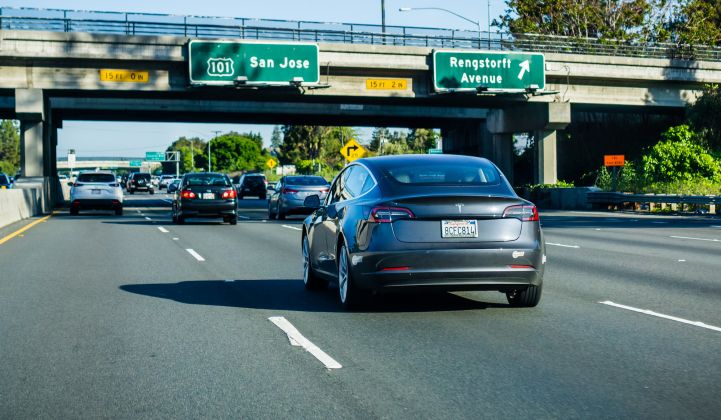The California Public Utilities Commission gave the go-ahead Thursday to wide-ranging proposals from the state’s large investor-owned utilities to expand electric vehicle infrastructure and rebate programs with a total budget of more than $750 million.
The approved plans mark the state’s largest investment in electrification to date and build on smaller-scale utility-sponsored EV programs now underway. Though the state is often lauded as a climate leader, California also happens to have a car-centric culture and many of the country’s most active ports. Transportation accounts for 39 percent of the state's emissions.
“What we’re seeing is one of the largest and most well-thought-out approaches to advancing electrification of vehicles,” said Adrian Martinez, a staff attorney at Earthjustice who focuses on vehicle electrification. “I think a lot of other utility commissions and other folks across the country are going to be looking at this.”
All the efforts are required under California’s 2015 SB 350 bill, which mandates that the state get half its electricity from renewable resources by 2030. California now looks set to surpass that goal and has considered increasing its target. In a January executive order, Governor Jerry Brown also set a goal for 5 million zero-emissions vehicles in the state by 2030.
The plans approved Thursday include a more substantial focus on medium- and heavy-duty vehicles than the previously approved pilots, as requested by the utility commission. They also emphasize locating infrastructure in disadvantaged communities, in an effort to make charging accessible and improve air quality in communities that suffer disproportionate impacts from pollution.
Martinez said California’s attention to diverse transportation categories, like trucks, buses and port equipment, makes its approach unique. Carlo De La Cruz, senior campaign representative at the Sierra Club’s My Generation campaign, which works to promote 100 percent clean energy in California, said the state's tactic to use “regulations working in tandem with the business community” sets it apart from other states such as New York and Washington that are moving forward on transportation electrification.
Under the approved proposals, Pacific Gas & Electric will invest up to $236 million in infrastructure and rebates for up to 6,500 medium- and heavy-duty vehicles such as trucks, cranes and forklifts across 700 commercial and industrial sites. It will also receive $22 million to add 234 DC fast-charging stations for passenger vehicles at 52 sites.
San Diego Gas & Electric will get $137 million to offer rebates and installation services for a cap of 60,000 customers for charging at home and at small multi-unit dwellings.
The largest investment goes to Southern California Edison, which has an upper limit of $343 million for up to 8,500 medium- and heavy-duty vehicle infrastructure investments at 870 sites. The utility will also experiment with time-of-use rates for charging all types of vehicles. SCE said electrifying transportation represents a "key component of the company’s vision for a clean energy future."
The budget for these projects comes to approximately $738 million, with an additional $29.5 million for program evaluation ($10.3 million for PG&E, $5.5 million for SDG&E and $13.7 million for SCE).
PG&E told GTM that it is still reviewing the entire final decision, but is "pleased that the commission has approved us to move forward with these important electric transportation projects." The utility received far less positive news last week when investigators found PG&E at fault for several Northern California wildfires.
De La Cruz said the EV charging news is especially significant for Southern California, where the logistics and shipping industry disproportionately pumps pollution into low-income neighborhoods and communities of color. The heavy investment in Southern California Edison territory signals an attempt to cope with the legacy of environmental and health impacts in those areas, and to make sure those neighborhoods reap the benefits from transportation electrification.
Though the amended programs earned unanimous approval from the commissioners on Thursday, critics including ratepayer advocacy groups and the natural-gas industry initially opposed the extent and price tag of the plans. In the San Francisco-based meeting, Commissioner Carla J. Peterman recognized those disagreements and the compromise that went into devising the final programs.
“This range of opinions is not surprising. This is a new space. There is uncertainty regarding cost and impacts and what models are most appropriate for charging. But I appreciate everyone coming together to figure out how to put together a reasonable portfolio,” she said in the meeting. “I think the proposed decision overall is consistent with our guidance and balances well these competing aims of accelerating EV adoption, enabling competition, reducing cost and being sustainable and fair investments for EV drivers and ratepayers.”
Martinez said the program will “provide an initial jolt to electrification” in the state, but he added that it might not be long before the utility commission must consider additional funding and proposals, based on the acceleration of electrification.
“For better or worse, I think this money is going to go quickly, and I think we’re going to see the need for even more investment.” said Martinez. “Some would argue we need even a lot more than what’s being considered here, but I think this is a good start.”
Last week California also approved a portion of an additional $423 million for electric vehicles from Volkswagen, bringing investment in EVs and infrastructure from that settlement to over $1 billion.
The CPUC lifted a ban on utility investment in electrification at the end of 2014. Since then, Peterman said the commission has approved nearly $1 billion in electrifying the transportation sector — with an eye toward setting an example, in true Californian fashion.
“Other states are watching; other utilities are watching,” said Peterman. “The hard work really begins now, in the implementation of these programs.”
This story has been updated with additional information.




